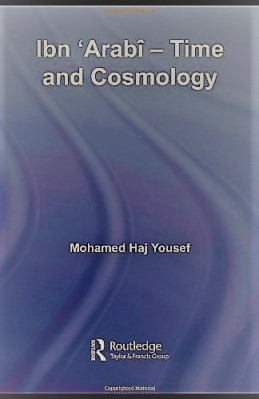
| Time And Cosmology |
| Ibn al-'Arabi |
| 246 |
| 1.7 Mb |
| |
| PDF Direct Download Link |
| Click for Hard Copy from Amazon |
TIME AND COSMOLOGY – Book Sample
TIME AND COSMOLOGY
Cosmology is the science that studies the universe, the cosmos. Cosmos is a word used in earlier Greek metaphysical thought that means ‘harmony’ or ‘order’, as opposed to chaos. In one Greek theory of creation, chaos is the form-less matter from which the cosmos, or harmonious order, was created (EP: ‘Cos-mology’, II: 237–244; ‘Chaos and Cosmos’, II: 80–81). And time is one of the most fundamental issues in philosophy and cosmology, since the whole of exist-ence is nothing but consecutive series of events in time. Everybody feels time, but most people do not question it because it is commonly Everybody feels time, but most people do not question it because it is commonly experienced every .
Throughout the history of philosophy, many opposing views have emerged to discuss and describe the different aspects of time, and some novel hypotheses have eventually emerged in modern cosmology. However, it is still the dream of every physicist to unveil the reality of time, especially since all modern theories have come to the conclusion that time is the key.
1.1 A brief overview of early cosmological models – TIME AND COSMOLOGY
Beginning in the twelfth century, Arab scholars, scribes and various translators gradually introduced Europe to the science of astronomy as it had developed in Islamic civilization, based on earlier Hellenistic models (primarily Ptolemy and Aristotle). But once the Catholic Church had decided to adopt the Ptolemaic or Aristotelian geocentric1 cosmological model as a theological principle, it consid- ered scientists who criticized this model as heretics. Therefore, the Polish scien- tist Nicolai Copernicus (AD 1473–1544) circulated his heliocentric model anonymously, and his book De Revolutionibus Orbium Caelestium (‘On the Revolutions of the Heavenly Orbs’), was not published until 1543, just one year before his death. In this model, Copernicus postulated that the Sun and the stars are stationary and the Earth and the planets circulated around the Sun in circular orbits.2
It was not until 1609, when Galileo invented the telescope, that Aristotle’s and Ptolemy’s geocentric model of the universe was completely discarded by knowledgeable researchers, and replaced by the heliocentric model (Drake 1990:145–163). At around the same date (1609–19), the scientist Johannes Kepler for- mulated three mathematical statements that accurately described the revolution of the planets around the Sun. In 1687, in his major book Philosophiae Naturalis Principia Mathematica, Isaac Newton provided his famous theory of gravity, which supported the Copernican model and explained how bodies more gener- ally move in space and time (Hall 1992: 202).
Newton’s mechanics were good enough to be applied to the solar system, but as a cosmological theory it was completely false in so far as he still considered,
1.2 Modern cosmology
Since Copernicus’ time, our view of the cosmos has grown both larger and more accurate. It is not our purpose here to explain the modern complicated theories of cosmology, but simply to summarize the present picture of the cosmos as seen by scientists. Our modern picture of the cosmos dates back only to 1924, when Edwin Hubble showed that our galaxy is not the only one in space; many of the faint spots of light that we see in the sky are in fact other galaxies as large as our own, but we see them so small only because they are extremely far deep in space. Owing to the force of gravity, everything in the sky is moving or orbiting around some point in space. The Moon orbits around the Earth, and the Earth and other planets orbit around the Sun, which also orbits – along with other hun- dreds of thousands of millions of stars – around the centre of the Milky
thick. The nearest galaxy to us lies in the Andromeda constellation, and it is about 2.9 million light years away. Then galaxies are grouped in somewhat irregular clusters that greatly differ in size from millions to hundreds of millions of light years. The most distant objects discovered so far are about 13 billion light years away. These numbers are simply approximate, just to give an idea of where we are (Hartmann 1990: 413).
It is now also well established that everything in the world is moving: nearby stars have proper motion, because they are pulled towards the centre of the galaxy, and galaxies are moving away from us, because the universe is expanding. ..
To read more about the Time And Cosmology book Click the download button below to get it for free
or
or
for websites
 Don't Miss out any Book Click Join OpenMaktaba Telegram group
Don't Miss out any Book Click Join OpenMaktaba Telegram group